The Ukrainian Ministry of Foreign Affairs gathered five remarkable stories of Ukrainians helping citizens of other countries during World War II.
1. The Dutch officers that UPA helped escape from a POW camp in western Ukraine
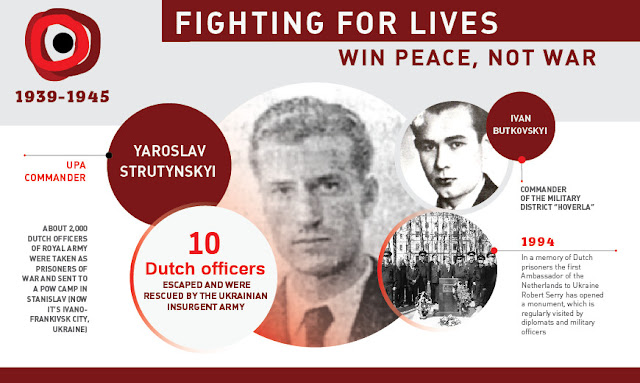
The Netherlands were one of the first countries who were divided and occupied by Nazi Germany. About 2,000 Dutch officers of Royal Army were taken as prisoners of war and sent to a POW camp in Stanislav (now Ivano-Frankivsk city, Ukraine).
During an evacuation, several groups of Dutch prisoners planned their escape. Two officers Joop J. Singor and Syp van der Pol made their way to freedom by crawling under the stage of the camp’s theater.
Two other groups of escapees, among them Edward J.C. van Hootegem, Kees Harteveld, Harm Lieneman, Piet de Ruijter, Frans J.G. Brackel, Leen A.D. Kranenburg, Johannes Adolfbaron Bentinck and Geert G.C. Bijl de Vroe successfully jumped off a moving train as it pulled out of Stanislav.
After escaping, the Dutch officers went towards the Carpathians to Hungary. During their travels in western Ukraine they were found by members of the Ukrainian Insurgent Army (UPA). The UPA was informed by the local people about the fugitives. While Ukrainian partisans were observing the Dutch officers, moving from one farmhouse to another, they tried to establish their real identities.
The risks to the UPA for providing assistance were high. There was a constant threat of running into Germans, who were patrolling the main thoroughfares. There were also risks associated with survival during the dangerous journey through the mountains in the middle of a snowy winter.
Lt. Gen. Edward J. C. van Hootegem: “Our experience was certainly not devoid of humour for, whatever the circumstances, a Galician retains his easygoing nature and relaxed attitude.”
UPA leaders provided temporary shelters for the Dutch officers in Ukrainian villages. Later they transported them safely to the Hungarian border. The route to Hungary and the transfer of Dutch officers there were thoroughly planned by the UPA.
Then, on returning home, the 10 officers continued to serve and became part of the military leadership of the Netherlands.
2. The Greek Catholic priest that organized a secret church unit to evacuate Jews
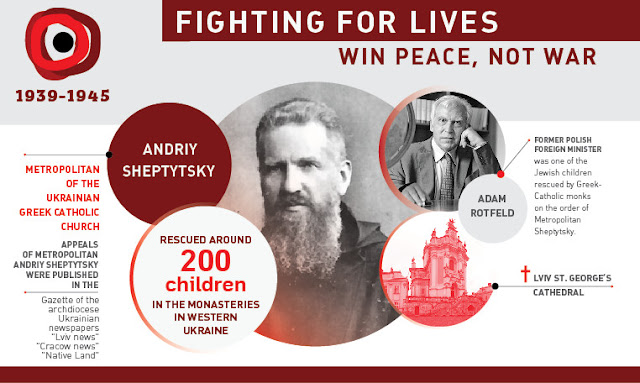
A lot of Ukrainians saved Jewish people during the Holocaust. As for the year of 2014, Ukraine was the 4th in the Yad Vashem list, which included 2,472 Ukrainians as Righteous Among the Nations.
The Jewish community calls this man “a saint”. The Metropolitan of the Ukrainian Greek Catholic Church Andriy Sheptytskyi and his brother Clement during the Holocaust harbored and assisted Jews suffered from German genocide operations.
A rescue operation of nearly 200 Jewish children organized by him is unique in the history of the World War II.
The mechanism of mass extermination of Jews was exercised by Nazis from the very first days of occupation in Galicia. Metropolitan Andriy Sheptytsky created in the Lviv St. George cathedral a group of reliable people: priests, laymen and monks, who was organizing a harboring of Jews. So within the church structure a secret unit aimed at protection, hiding and safe border transfer of Jews to Romanian and Hungarian zones of occupation was formed.
Moreover, Sheptitskyi publicly appealed to the clergymen and religious persons with a message of solidarity with Jews. In conditions of anti-Semitic propaganda it was almost the only available way of direct impact on people. And it was really effective.
3. The Greek Catholic Priest that issued 600 baptism certificates to Jews
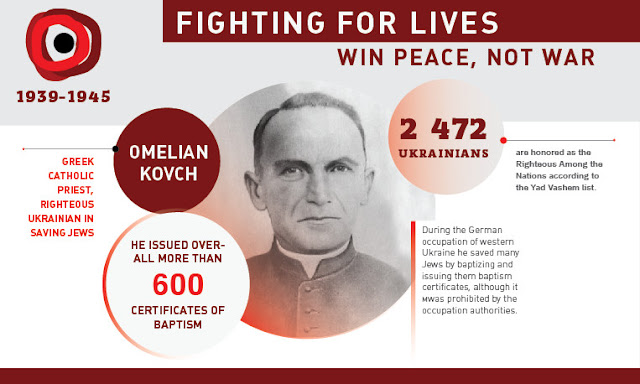
There are numerous facts of harboring Jews by Ukrainians during the Holocaust. Usually, the best option for saving Jews and their own lives (after all, helping Jewish families was severely punished) was a “legalization” of representatives of the Jewish community.
To take a baptism was one of the ways of such “legalization”. Thus, the mayor of Kremenchug Mr.Verhovsky built barracks in the suburbs and settled there over a thousand Jews. Some of them were baptized and received Christian names.
Another Righteous Ukrainian was a wellknown Greek Catholic priest Omelian Kovch. During the German occupation of Western Ukraine trying to save Jews from extermination, Kovch baptized them and issued them baptism certificates, despite the ban of the occupation authorities. Totally, he issued more than 600 certificates of baptism.
Sometimes, Ukrainians married Jews in order to save their lives. People also gave their own documents to Jews to conceal their origin.
4. The Ukrainian who took charge of the French resistance movement
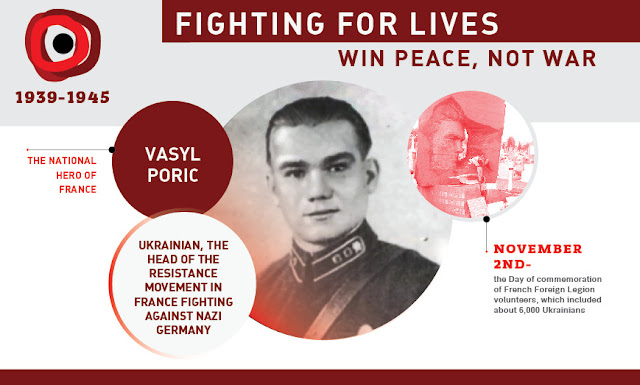
There is a wall in the French city Arras well known as the monument to 218 patriots from various towns and Resistance Groups who were shot in the ditches of the citadel by the German occupiers between 1941 and 1944. There is a name of Vasyl Poric, Ukrainian who became the National Hero of France.
Vasyl Poric came to France in 1942 among the hundreds of prisoners who were brought by Nazi Germany to the Beaumont-en-Artois Camp in the northern France. Not being able to fight against the Nazis on the front line, Vasyl Poric took charge of the resistance movement. Such resistance groups used all opportunities to commit sabotage against the enemies. They damaged expensive and rare equipment, destroyed troop trains with coal and armament.
The activities of Poric’s resistance movement were so significant that after the end of war Ukrainian was awarded with the title of the National Hero of France.
5. The Ukrainian who saved Krakow from destruction
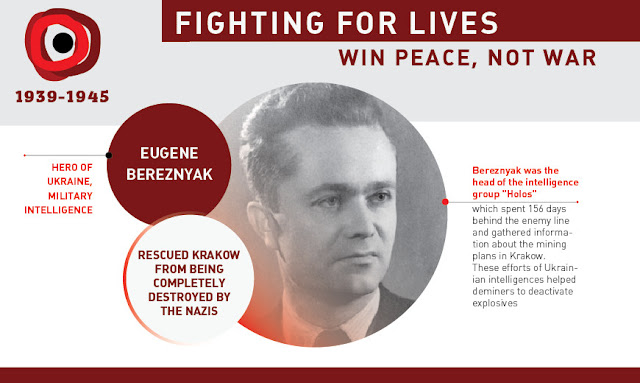
Mutual assistance between Ukrainians and Poles existed even in the most complicated periods of relations between the two nations. We can continue never-ending historical disputes on the events of the past, but those who survived that days have nothing to divide. The facts of heroic rescue truly unite many Ukrainian and Polish families even today.
Entire cities in Poland owe to Ukrainian military their salvation from certain death.
In 1944, retreating Nazis prepared a plan and started to seed Krakow with mines. Vehicles and industrial facilities had been mined first. Mines were deployed in historic city center also. Scouts led by Ukrainians Eugene Bereznyak from Dnipropetrovsk and Alexey Shapovalov from Kirovograd got information about the plan. Berezniak commanded the reconnaissance group “Holos” (Voice), which spent 156 days behind the enemy line and had entirely explored Krakow. The collected information about the disposition of the Nazi armies, corps and divisions was transferred to the headquarters of the 1st Ukrainian Front. Due to this data mine-pickers promptly demined the explosives and the city of Krakow was saved.
Related:
- Understanding the Ukrainians in WWII — Part 1
- Understanding the Ukrainians in WWII — Part 2. Stories of Ukrainians in the Red Army
- Understanding the Ukrainians in WWII — Part 3. Of German plans and German collaborators
- Top-6 Soviet World War II myths used by Russia today
- 97 y.o. Ukrainian World War II hero lost his grandson to war in Donbas
- Putin’s tactics in Ukraine now recall Stalin’s actions there in World War II
- Compelling proof: Polish parliamentarian published report on Russian war crimes in Ukraine




